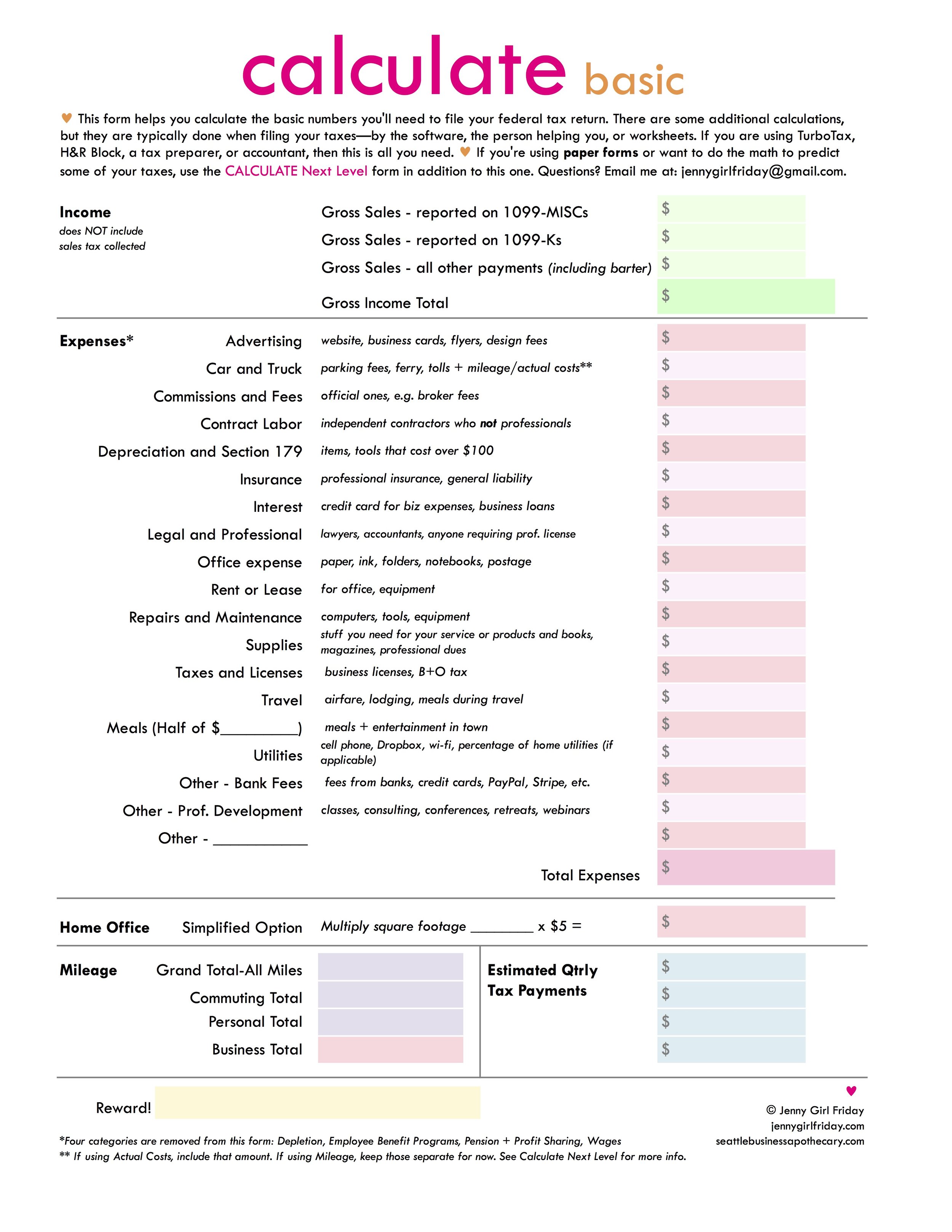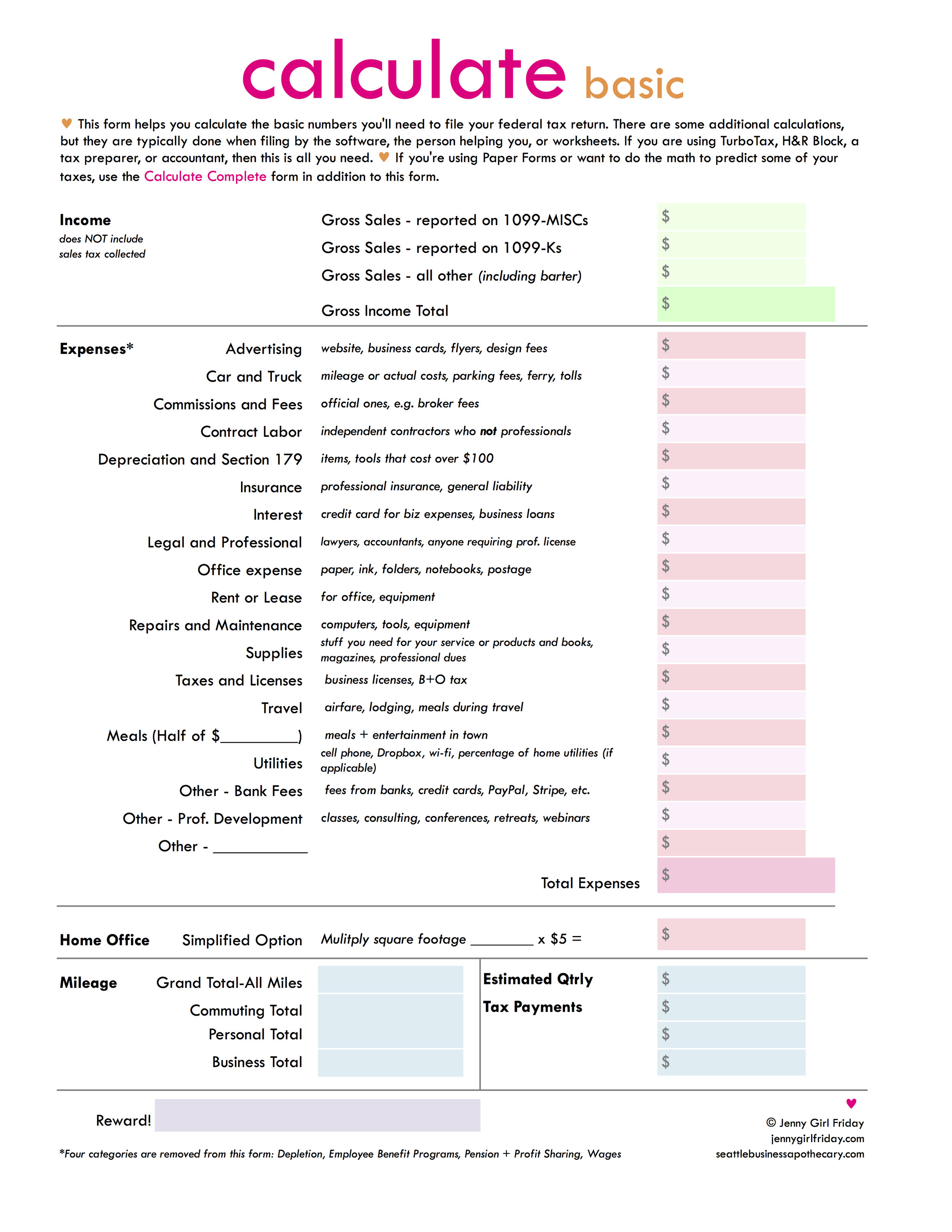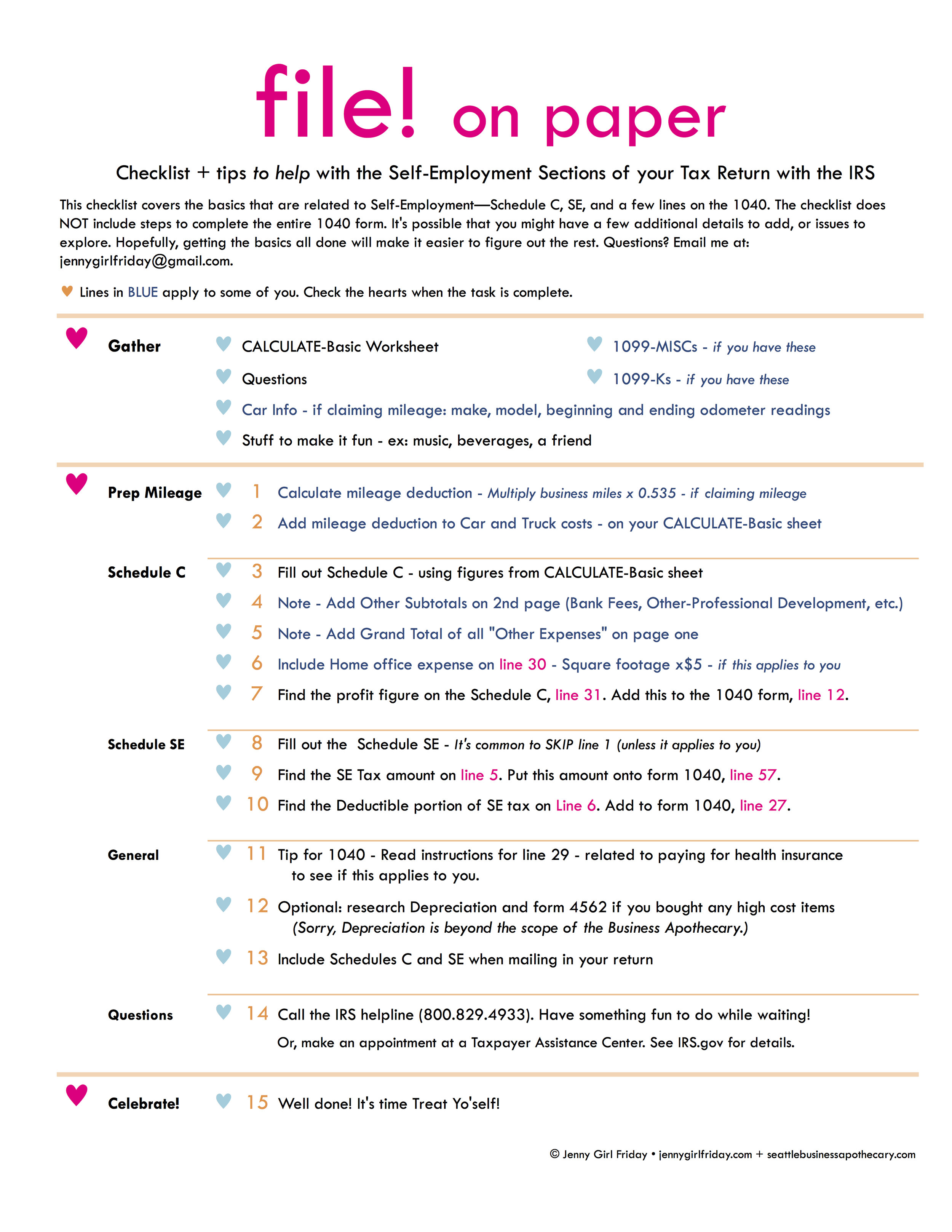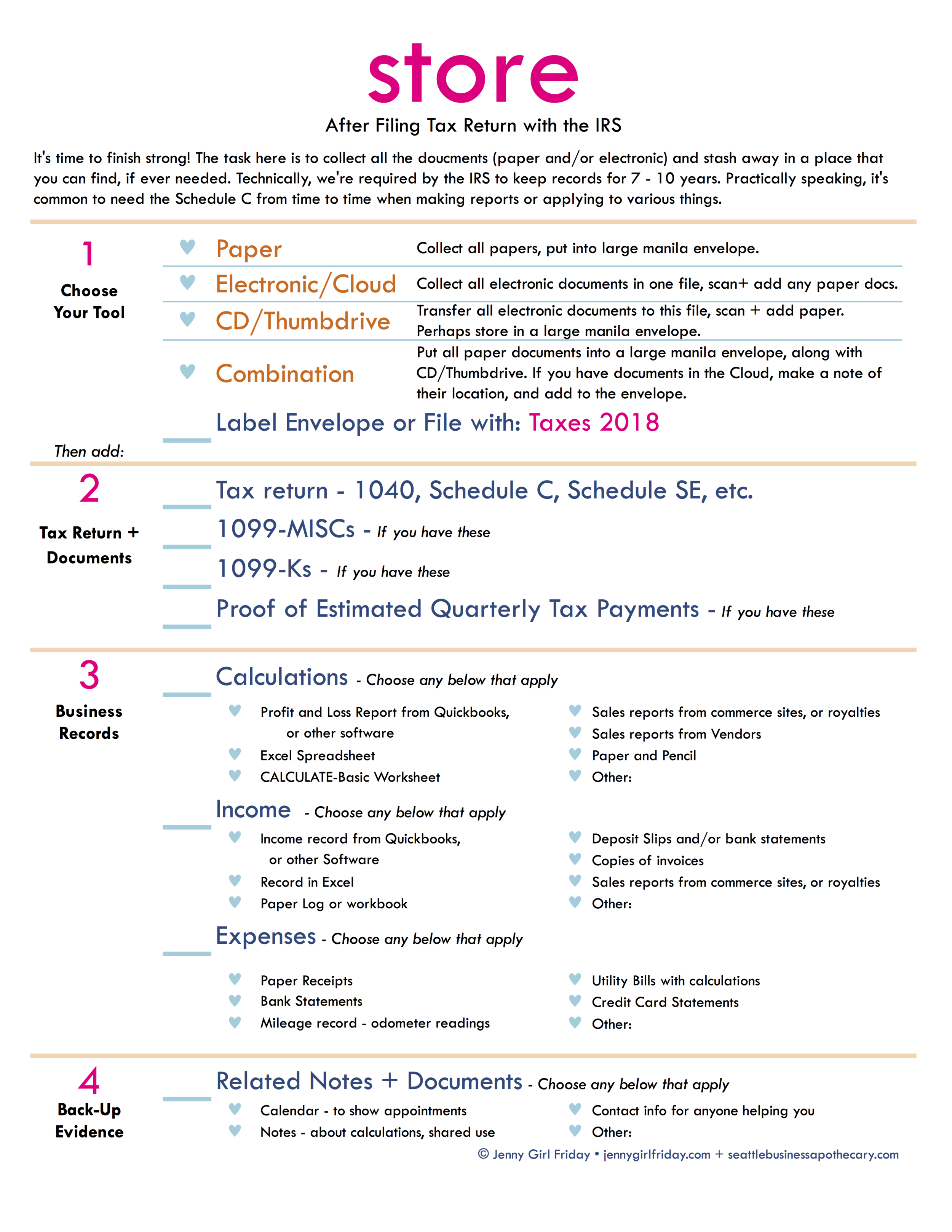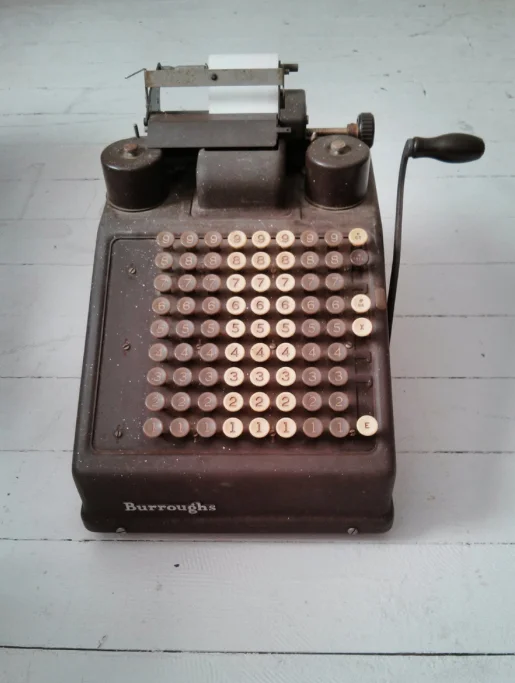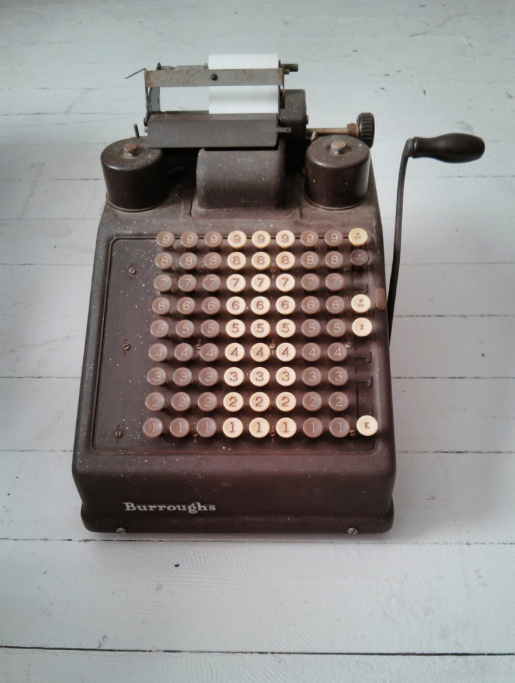• How to CALCULATE numbers for IRS taxes: pen and paper, spreadsheets, software
[Note: This is step three of the Prep for IRS Tax process. To see all the steps, click here.]
In a nutshell
You need to report some numbers related to your business AND have some evidence to back them up (receipts, bank statements, etc.). How you add up the numbers is up to you!
The numbers (eventually) get reported on the Schedule C. If you use software or a tax preparer, they will ask you questions, then put those numbers onto the Schedule C for you.
Consider using the handy worksheets below to keep track of your numbers.
Alert: This blog post may look really complicated, and I apologize for that! It's tough because every situation is different, and I'm attempting to speak to a variety of situations in one post. ♥ Please know: once you get into the material, it usually starts to make sense. Also, I invite you to email me with any questions! jennygirlfriday@gmail.com
ProTip: Print the Calculate-Basic worksheet, and just start filling in what you know. Then come back to the post for more ideas when needed.
ProTip: Get a friend to help you with this. They can read the instructions, then together, you can figure out how to proceed.
The Calculate-Basic includes everything you need for MOST situations. The Calculate-Next Level is helpful if you're planning to file using paper forms, or if you want to predict your self-employment tax amount.
Gross Sales
AKA Gross Income / Total Deposits
Important: This number NEVER includes any sales tax collected.
You need to have a total Gross Sales number, and a record to back this up. Perhaps you already have this total, or parts of it.......or perhaps you have to create it still. Here are some options.
Different Ways to Keep / Create a Gross Sales Record
If you already have this record, great! If you need to make one up for last year, read on! The basic process is:
1 Find the payment amounts
2 Make a Record
3 Find the Total
4 Format for the IRS
1 - Find the payment amounts
Here are all the places to look:
- Bank Statements - look at deposit records
- Deposit Slips
- Copies of Receipts/Invoices
- Reports from Commerce sites
- Calendar - find all appointments and mark what you got paid for each
2 - Make a Record
Ideally, include the date, purchaser name, and amount of each.
These are options for you to choose from:
- Keep a list of all payments in a notebook
- Record payments in a spreadsheet
- Print out all summary reports from websites you use, keep as your records
- Use software or an app (such as Quickbooks or Fresh Books)
3 - Find the Total
Add up all your numbers to find your Total Payments by customers. This is your Gross Sales.
Do NOT include any sales tax collected.
- Use calculator
- Put into a spreadsheet, and use formulas to add
- If using software, go to the Reports section to get the totals
4 - Format for the IRS
Did you get any 1099-MISCs or 1099-Ks for your business? These are simply proofs of payments that someone else made to your business. The numbers on these forms should already be included in your Gross Sales amount.
> If you're filing with Paper Forms, then you just report your Gross Sales, which includes the totals on these forms. You do NOT need to list out their amounts separately.
> If you're filing with software or an accountant, they will ask you for your Gross Sales in parts. So you'll need to find the subtotals for:
___1099-MISCs
___1099-Ks
___ All other payments (including barter)
___ Total of Gross Sales
Expenses
Okay, options! Here are three of my favorite. There are more options and variations. Hopefully this will give you an overall idea, and you can create something that works for you.
Note: For evidence of our business expenses, receipts from the purchase are best. The IRS will also accept bank and credit card statements.
Pen and Paper
With Receipts
1. Look at the categories of business expenses (on the Calculate-Basic sheet or the Schedule C)
2. Make piles with your receipts in each category.
3. Add up the totals for each, and fill in the chart. Perhaps write these amounts on pieces of paper to keep track, one for each category.
4. Suggested: staple each stack of receipts together.
With Bank Statements
1. Look at the categories of business expenses (on the Calculate-Basic sheet or the Schedule C)
2. Get a piece of paper for each category, label at the top.
3. Go through Bank Statements. Find each business expense. Highlight, circle, or underline it on the statement.
4. Decide which category the expense falls in. Write each expense on the corresponding piece of paper. (For example, if you see a line for "Office Max", write the amount on the paper that labeled "Office Expense".)
5. When all expenses have been recorded, add up to get the totals. Record on the Calculate-Basic worksheet by category.
Spreadsheet
1. Look at the categories of business expenses (on the Calculate-Basic sheet or the Schedule C)
2. Label a column or separate tab with each category. (Depending on how you like to work.)
3. Go through your receipts and Bank Statements. Find each business expense. Highlight, circle, or underline on the statement.
4. Decide which category the expense falls in. Add it to the column or the tab.
5. When all have been recorded, add up to get the totals. Record on the Calculate-Basic worksheet.
Quickbooks or Other Software
1. Finish inputing/uploading all expenses for 2017
2. Find the Reports page
3. Select Profit and Loss statement
4. For the time period, select Last Year
5. Look at the report. Review each category.
6. Make any adjustments.
7. Print the Profit and Loss statement. Or, record the amounts on the Calculate-Basic sheet.
Special Expenses
These get calculated in special ways, so deserve their own section.
Special Expense - Mileage
There are two ways to deduct driving expenses. For each vehicle, choose one method and stick to it each year.
Option A: Actual expense. (Less common)
With this option, you collect and report ALL costs associated with your vehicle: gas, insurance, repairs, maintenance, and tab renewals. If you use it part for personal and part for business, you need to calculate what percentage is used for business. Then take that percentage of the total costs.
So, if you use for business 30% of the time, you'd deduct 30% of all costs associated with that vehicle.
Add this expense to the Car and Truck Category.
Option B: Mileage Deduction (most common)
For every mile that you drive for business, you get to deduct a specified amount. In 2017 it was 53.5 cents per mile. With this method, you need to know your total business miles. Additionally, you're required to have a record. The easiest way is to use an app, such as MileIQ. Or, you can keep a log book.
For most forms of filing, you'll be asked for:
___ Starting Odometer reading, on January 1
___ Ending Odometer reading, on December 31
___ Grand Total of All Miles
___ Total of Personal Miles
___ Total of all Commuting Miles (driving to and from an office)
___ Total of all Business Miles
To Claim the Expense:
If using Paper Forms
A. Calculate Total Business Miles x 0.535 =____________.
B. Add this to your Car and Truck Total
If using Software or Working with a Tax Pro
A. Have all of your Mileage Totals Handy
B. Do NOT include in Car and Truck expense
C. Provide information when asked, and they will calculate and deduct
Special Expense - Home Office
If you have a home office that meets certain requirements, then you can make a deduction. There's a Regular Method (that's complicated) to do this, and a Simplified Method. I will only speak to the Simplified Method. To learn more, go to IRS.gov, or ask your accountant.
A. Decide if you meet the requirements: the space is ONLY used for business, and it is your principle work space.
B. Measure the Square Footage.
C. Multiply Square Footage by $5=_____________
D. If using Paper Forms, claim this expense on the Schedule C on Line 30. (It is in a separate place than other expenses.) Also, consider researching or asking someone about Schedule A. I have yet to learn about this.
E. If using software or working with a tax pro, input when prompted.
♥ If this is your first year..........hang in there........and just try your best! If you find out in the future that you did something wrong, or forgot some major deductions, don't worry, you can amend tax returns from previous years.
Actually, that goes for everybody. Just try your best. Take things one step at a time. Do what you can. Reach out for help: from a friend or colleague, email me, meet with a tax volunteer at the library, or your bookkeeper or accountant.
To read about options for Filing, click here.
For the next Tax Help Pop-up Shop, click here.
: ) Jenny Girl Friday
P.S. Know any other self-employed Seattleites who could use this information? Please forward freely!
P.S.2 Are you already signed up for Sidekick Services? If not, click here and join the list to receive tax + license reminders, how-tos, inspiration and more delivered to your inbox.
• How-To Prep for IRS Taxes (Includes fun + rewards!)
Prepping for taxes is a lot like planning a big party or fancy dinner. (Okay, maybe a little bit different.)
It's possible to do it all at once.........or to break it up over time. There are pros and cons to each!
Doing it all at once
....is more efficient, you get really in the zone, and sometimes adrenaline fuels quicker working. If this sounds good to you, click here.
Breaking up over time
....means the effort is less intense, you have time to catch important details, you can rest in between.
Either way, it's helpful to know early how you're going to file, so that you can line up any help, or make appointments. (For example, if you're planning to go to H&R Block, you'll need to find their open hours. If you're hoping to work with an accountant, they'll have their own deadlines for you, earlier than April 17th!) Click here to read more about options for filing.
Overview
I've broken up the process into several steps, which can be spread over days/weeks, or done all at once. More details about each step below. Please keep in mind: as a project manager client once explained to me.......when you break things into many steps, each step looks easier, but then, you have a lot of steps! Don't let this discourage you. Just find a way to start, and, in theory, each step should feel easy and quick, and you'll build momentum.
0. Review REWARDS Menu (optional + recommended)
1. WARM UP
2. COLLECT stuff (coming next)
3. CALCULATE some numbers - Basic + Next Level
4. CHECK + find any missing pieces
5. FILE / SUBMIT along with your IRS taxes - File-paper, File-online, File-tax pro
6. STORE tax forms and back up document
7. Optional: Reward + Reflect
It can look like a lot! And feel like a pain! It can also be very rewarding, and I'm determined to help you build in some fun.
Warming Up
Warming up ... okay, so you don't have to, but it will make things more pleasant.
It's like stretching before playing soccer, or better yet, like a cocktail + appetizer before dinner!
As part of our Tax Prep, Warming Up includes picking a due date, your option for filing, considering your way of working, putting time on the calendar, and most importantly...........finding ways to make it fun and picking rewards!
Click on the image to get a downloadable PDF.
You might notice that I often refer to inviting a friend to join you for some of this work. I'm not kidding about this! If you make an appointment with a friend, you're more likely to do the work (not put it off), it's way more more fun, it can go faster, and they can help you figure out anything confusing. Most often, friends are happy to lend a hand in exchange for dinner, a bottle of wine, a candle, or just some sincere thanks.
Do you have someone who could keep you company with this?
Collect Stuff
AKA.....Treasure Hunt Time!!!!!!
I love this step. Can you tell? Here's why. Every receipt you find for business expenses is like finding $$$$$! Depending on your specific tax scenario...for each receipt, you'll be saving 20 - 30% of what that receipt is worth.
For example, if you bought a few books for your business, and the cost totaled $80...then you'll pay $16 - $24 less in taxes.
With this step, we're just collecting stuff. No adding, no smoothing receipts, just find it.
ProTip: create a spot somewhere to put all these things, or perhaps a very pretty basket, or decorated office box.
Heads up: it's very helpful to print a lot of records, so you may have to stock up on some ink. (I like to use remanufactured ink to save money.)
Click on the image to get a downloadable PDF.
Calculate
So.........you don't pay too much!
>>> If you know what to do, or would like to just figure it out as you go, print the Calculate-Basic sheet and start filling in numbers.
Why we're doing this
Before we talk about the numbers we need, let's review why we have to do all this work. Basically, it's so that you don't pay too many taxes! The IRS taxes you on your Income. When you are a sole proprietor or single-member LLC, the profit from your business is considered your income.
If you were to only report your total payments (gross sales), you'd have to pay taxes on that entire amount...even though you likely had to spend money on running the business. That wouldn't be fair. Thank goodness, we don't have to do that! Instead, we report our profit, and we're taxed on that. In order to report our profit....we required to report several numbers, as a sort of proof. Here's more on that....
The Basic Numbers + Formula
To find our profit, we report the following numbers + formula:
Gross Sales
- Expenses
= Profit
Two of those numbers (gross sales and expenses) are made up from several other numbers, and have to be reported in the right way. The IRS created the form Schedule C for sole proprietors and single-member LLCs. The worksheets I created are simplified versions of the Schedule C.
Gross Sales, may include:
- totals from 1099-MISC, given to you
- totals from 1099-K, given to you
- totals from all other payments, including barter
Expenses, may nclude:
- totals by category of business expenses
- total business miles
- square footage of home office
The Calculate Step
In this step, the idea is to find these numbers. It's possible you have them already if you've been keeping records, or using a program such as QuickBooks.
[Even if you have these totals, it's great that you've collected your receipts and bank statements, because these are part of the evidence that you need to keep for several years—7, I think?—in case you get audited. (Btw, good news, less than 1% of people get audited.)]
If you still need to calculate your totals, and would like some guidance, click here to read more about this. There are several ways to do this! Just a few include: pen and paper, spreadsheets, and software. Find what works best for you, and consider getting a friend to help.
Check
Congrats! You've finished the CALCULATE step, often the longest one. By any chance, did you discover that you were missing some things? Or did you have new questions as a result of your work?
That's super normal! That's what the Check + Find is about: finding missing things, getting answers, and double-checking your math. This step is optional. It's offered for those of you who like to be very thorough before filing.
This checklist prompts you to check the math you've done so far (income subtotals, expense totals, mileage).
+
There's space to list questions and things to find. Use it to keep track of your progress.
File!
It's finally here, the big moment.
Well, actually, with all your amazing prep work, this part is likely to go rather quickly. :)
There are slightly different actions to take, depending on which way you're filing. The worksheets to the left work for:
• Filing Online - TurboTax, H&R Block, TaxAct, etc.
• Working with a Tax Pro - Accountant, CPA, preparer, volunteer
Each checklist covers the basics that are related to Self-Employment—Schedule C, SE, and a few lines on the 1040. The checklists do NOT include steps to complete the entire 1040 form.
It's possible that you might have a few additional details to add, or issues to explore. Hopefully, getting the basics all done will make it easier to figure out the rest.
(Please note: Technically, these are not guides, they are reminders in a logical order. This blog is for tax education, and doesn't constitute tax advice.)
♥ They might look long, but don't worry too much! They only look long because I wrote out each little step separately.
♥ Remember to get a friend to keep you company, and/or make the job fun with things like favorite music, treats, a show in the background.
♥ Also, when you're finished with this step, be sure to give yourself the reward you identified! It's common to be too tired and relived to care, and to skip the reward. Please don't! You deserve it.
Store
Phew! You're almost done. There's just one last crucial step - to Store everything away. You might be thinking, I'm over this! I'm done! I get it, that's super reasonable....and I promise, this last step is worth it and feels really, really good.
It's your choice: you can shove papers in an envelope or file willy nilly. Or, put things in place...neatly, and methodically. Either way, you'll feel so much satisfaction, relief, and closure.
And, if ever in the future, you do need these documents, you'll be SO glad that you did this.
As usual, I invite you to add a reward for this step, even though it's not on the checklist!
Optional: Reward + Reflect
Well done! You just finished a big job. It's essential that you reward yourself. (This is part of staying in the game of self-employment.)
Hopefully, you already did this. If not, now's your second chance.
Also, right now, fresh off the job, is the BEST time to make a change or two, to make life easier next tax season, and throughout the year. Do your future self a big favor by taking just 5 - 10 minutes to reflect!
Yay! Now we're really done. :)
You got this!
♥
Jenny Girl Friday
P.S. Know any other self-employed Seattleites who could use this information? Please forward freely!
P.S.2 Are you already signed up for Sidekick Services? If not, click here and join the list to receive tax + license reminders, how-tos, inspiration and more delivered to your inbox.
• IRS Taxes - Different Options for Filing, from Paper to CPAs and in between
Please note: this is an evolving blog post.
I'm hoping to do continued research on this topic! (Perhaps with your help.) What you see below is what I know currently, I'll continue to revise and refine this post over time. If you have any information, feedback, input, or questions, please get in touch! Email me at: jennygirlfriday@gmail.com.
There are several great options for filing your IRS Taxes. This year, they are due on Monday, April 15th.
When you're self-employed, there are just two additional forms that get added to your normal taxes. The Schedule C and the Schedule SE. They're not too complicated. (Schedule SE looks a bit crazy, but really, there's only a few lines that you need to do!)
If you're filing with software, online, or with an accountant, usually, they will ask you a lot of questions, and then put your info into the forms. (Coming soon....Click here to read more about the forms, and what information you'll need for each.)
Filing Options
Here's a list, from the most basic to the most formal. More details about each below.
♥ Paper Tax Forms
♥ Free Online Portals
♥ Online Portals / Software (For Purchase)
♥ Tax Preparers / Bookkeepers
♥ Accountants / CPAs
♥Paper Tax Forms
Prefer the Old Skool Way? Paper tax forms still work just great….though the new 1040 is a little more tricky. The IRS took 2 sheets……and turned them into 7 half sheets. Weird, right? Oh well, knowing you, you’ll figure these out like a pro since you’re used to figuring it out. A post coming soon showing the new 1040…In addition to those, you’ll also need to fill out the the Schedule C and Schedule SE. You can download these directly from the IRS.gov site, or find at many libraries.
Variations
• Do on your own, using the instructions
• Get a friend for moral support and a 2nd set of eyes
• Use the Walkthroughs on the Business Apothecary, by Yours Truly (coming soon)
• Get free assistance at a Library, sponsored by the AARP
• Sign up for a Tax Pop-up Shop
Pros: You can see all your numbers. It's easy to double-check the information. It feels very satisfying and transparent.
Caution: Paper forms don't prompt you...so you might miss out on certain deductions, or credits. Such as the state sales tax deduction. (I have to look into that one still!)
♥Free Online Portals
I believe there are a handful of free portals to use. Usually, these work for basic tax situations only. Some can handle self-employment taxes.
One option is the IRS Free File.
Another is H&R Block, at hrblock.com
(Know any more good ones? Please send my way!)
Variations
• Do on your own, using the instructions
• Get a friend for moral support, and a 2nd set of eyes
• Use the Walkthroughs on the Business Apothecary, by Yours Truly (coming soon) to help you prepare your numbers ahead of time.
• Sign up for a Tax Pop-up Shop to get assistance with the self-employment section
Pros: It's free! It'll know about current tax credits, deductions, etc. It will prompt you for all the information.
Caution: It can be hard to get support when you run into trouble. The graphics aren't as easy or pleasing to the eye. Sometimes, there are limits...such as you have to earn under a certain amount.
♥(For Purchase) Online Portals / Software ... like TurboTax
Have you already been doing your taxes online with TurboTax or something similar? Then adding your self-employment taxes is pretty easy! The portal will guide you through a series of questions about your business, then it will do some of the math for you, and put all of your information into the proper tax forms (that get submitted electronically).
The golden standard is: TurboTax. A major benefit is....they are the same company that created QuickBooks. So, if you've been using those, it can be really quick to upload all your data right into TurboTax!
(Know any more good ones? Please send my way!)
Variations
• Do on your own, using the instructions
• Get a friend for moral support, and a 2nd set of eyes
• Use the Walkthroughs on the Business Apothecary, by Yours Truly (coming soon) to help you prepare your numbers ahead of time
• Sign up for a Tax Pop-up Shop to get assistance with the self-employment section
Pros: It'll know about current tax credits, deductions, etc. It will prompt you for all the information. It's easy to use. Excellent help available.
Caution: Sometimes one can get lost in the process. The portals guide you through, but it's sometimes hard to go back to change things. There are often a lot of up-sells, and it's hard to know when you really need them or not.
♥Tax Preparer / Bookkeeper
Do you feel better working with someone? Is your situation fairly straightforward? Working with a tax preparer or bookkeeper can be a great option! These are folks who are trained in, and very experienced with, doing basic taxes. They are different than CPAs (Certified Public Accountants), and usually cost less. Want to know more about the difference? Click here to read more on clearskybookkeeping.com.
Options:
H&R Block offers in-office assistance with using their portal, for a fee
(Know any more good ones? Please send my way!)
Variations
• Go into an office
• Hire a consultant to come to your office
• Sign up for a Tax Pop-up Shop for preparation of very basic taxes, including self-employment
Pros: Working with a real person to lead you through the process. Get answers to questions. Preparers will prompt you for all the information. They know all the things to check for at the end. Gives you a natural deadline for your preparation part.
Caution: Different personalities (sometimes folks are not friendly), tax preparers/bookkeepers may or may not know some of the very detailed laws that apply to your situation.
♥Accountants / CPAs (Certified Public Accountant)
This is the Cadillac approach! Accountants have a degree in their field, extensive training and experience with taxes, as well as a broader view of money in our lives, financial reports, investments, retirement, etc. They're who you need if you want to do any number modeling, get advice with decisions, do long-term planning, and more.
Some accountants are also CPAs. CPAs have to answer some additional and very high standards! They must have a professional license, follow a code of conduct, and get continuing education. CPAs are a great choice if you: have a complex situation (own properties, stocks, divorce, etc.), if it feels reassuring for you to the highest level of training for doing taxes, plan to grow into an S-Corp or change to a non-profit.
They will usually provide you with a questionnaire each year during tax season and a due date.
Options:
Many CPAs are moving to a subscription model, where you pay a monthly fee each month...and you get your annual taxes prepared + support year round. Some provide a quarterly check-in/tune-up plus annual filing. Personally, I think this is a great move!
Two CPAs with subscription models (that I've just learned about!) are:
• Timber Tax, with Luke Frye and Anne Chan at timbertax.co
• Hipster Money, with Alexandra Perwin at hipstermoney.com. (Website is still being developed.)
• Penny Smart Girl, with Meka West at pennysmartgirl.com
Some Accountants/CPAs are willing to do your once-a-year annual filing, and charge one fee for that job.
• Ballard Bean Counters, with Rose Westwood at ballardbeancounters.com
(Know any more good ones? Please send my way!)
Variations
• Go into an office
• Work over the phone and online
• Hire a CPA who also handles your bookkeeping
Pros: Working with a real person to lead you through the process. Get answers to questions. They can give advice. They can often save you money by knowing all of the credits and special rules! Gives you a natural deadline for your preparation part. You can reach out for help via email or the phone.
Caution: Different personalities (sometimes folks are not friendly). It still takes work on your part to prepare for the Accountant. Sometimes the portals that accountants use can be confusing.
Heads Up ~
However you choose to file your taxes—and with whom—it'll still be up to you to have the numbers and evidence for them. That's where I've got you covered! (Coming soon - Click here for a workbook.)
A couple parting thoughts ~
*****You have the right to be treated well by whoever is helping you with filing your taxes!***** If you ever come across someone who's being severe, unfriendly, or acting like you should know this stuff........then I invite you to move on! Find someone else. You're hiring them to help you! Your job isn't to know this stuff! Your job is to do your work, then find the paperwork + numbers that they ask you to get.
+
It actually is rewarding to do taxes. :) It sounds complicated. It interrupts your schedule. It can be confusing. Also, it is evidence of all the beautiful work that you did last year! Think about all the clients and buyers who benefited from your work! Look at all you accomplished! Every number represents income or expenses that you purchased to do your work. That's pretty cool.
Here's to a rewarding tax prep time!
♥
Jenny Girl Friday
P.S. Know any other self-employed Seattleites who could use this information? Please forward freely!
P.S.2 Are you already signed up for Sidekick Services? If not, click here and join the list to receive tax + license reminders, how-tos, inspiration and more delivered to your inbox.
